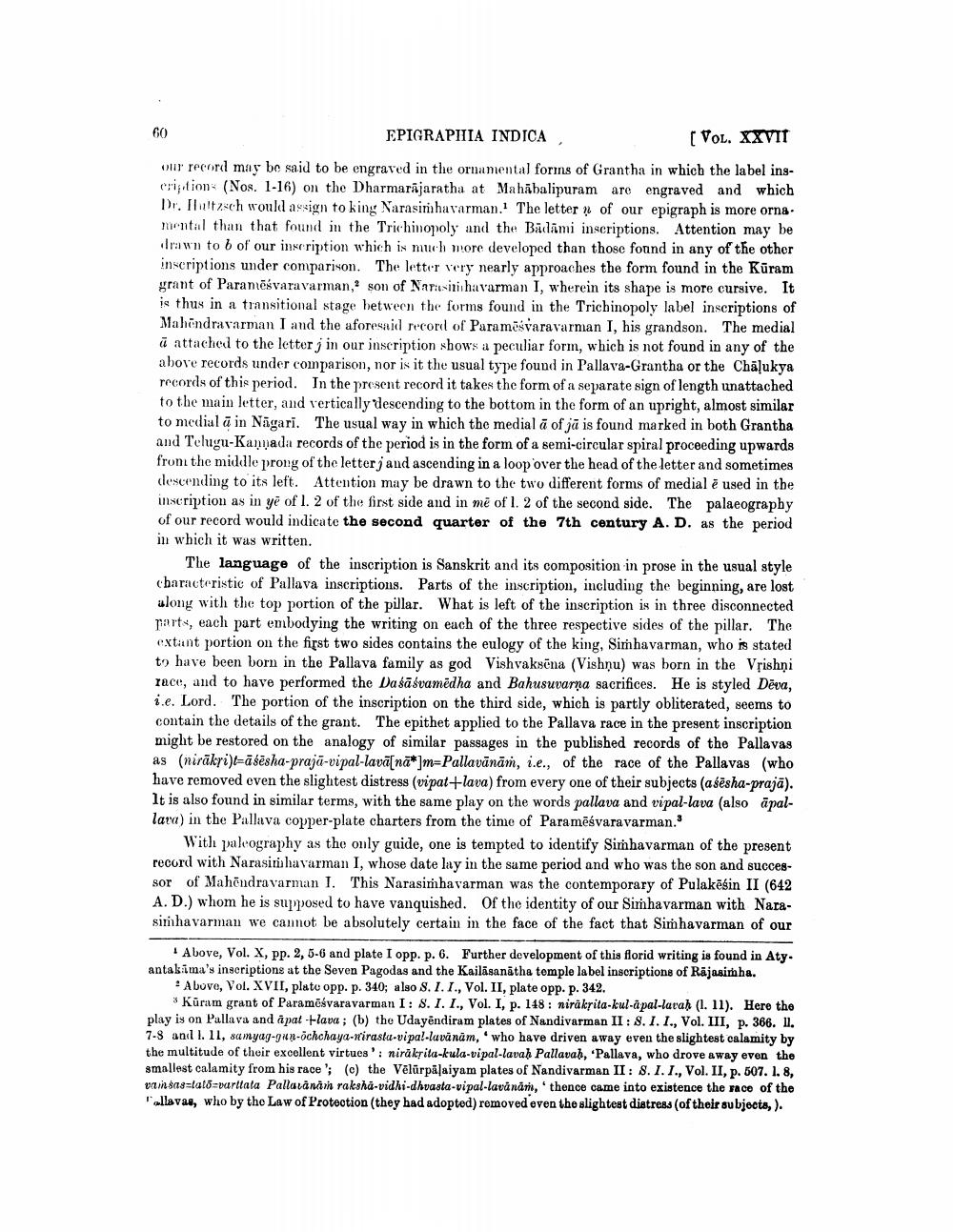________________
EPIGRAPHIA INDICA
[Vol. XXVII
our record may be said to be engraved in the ornamental forms of Grantha in which the label ingcription (Nos. 1-16) on the Dharmarajaratha at Mahabalipuram aro engraved and which Dr. Iultzsch would assign to king Narasimhavarman. The letter of our epigraph is more orna. mental than that found in the Trichinopoly and the Badami inscriptions. Attention may be
Irawn to b of our inneription which is much more developed than those found in any of the other inscriptions under comparison. The letter very nearly approaches the form found in the Kūram grant of Paranośvaravarman, son of Nariesiri havarman I, wherein its shape is more cursive. It is thus in a transitional stage between the forms found in the Trichinopoly label inscriptions of Mahindravarman I and the aforesaid record of Paramesvaravarman I, his grandson. The medial ū attached to the letter j in our inscription shows a peculiar form, which is not found in any of the above records under comparison, nor is it the usual type found in Pallava-Grantha or the Chāļukya records of this period. In the present record it takes the form of a separate sign of length unattached to the main letter, and vertically descending to the bottom in the form of an upright, almost similar to medialā in Nāgari. The usual way in which the medial ã of jā is found marked in both Grantha and Teluyu-Kannada records of the period is in the form of a semi-circular spiral proceeding upwards fron the middle prong of the letter j and ascending in a loop 'over the head of the letter and sometimes descending to its left. Attention may be drawn to the two different forms of medial é used in the inscription as in yê of l. 2 of the first side and in mē of 1. 2 of the second side. The palaeography of our record would indicate the second quarter of the 7th century A. D. as the period in which it was written.
The language of the inscription is Sanskrit and its composition in prose in the usual style characteristic of Pallava inscriptions. Parts of the inscription, including the beginning, are lost along with the top portion of the pillar. What is left of the inscription is in three disconnected parts, each part embodying the writing on each of the three respective sides of the pillar. The extant portion on the first two sides contains the eulogy of the king, Simhavarman, who is stated to have been born in the Pallava family as god Vishvaksēna (Vishnu) was born in the Vrishội race, and to have performed the Daśāśvamēdha and Bahusuvarna sacrifices. He is styled Dēva, i.e. Lord. The portion of the inscription on the third side, which is partly obliterated, seems to contain the details of the grant. The epithet applied to the Pallava race in the present inscription might be restored on the analogy of similar passages in the published records of the Pallavas as (nirāksi)=āšēsha-prajā-vipal-lavā[nā*]m=Pallavānām, i.e., of the race of the Pallavas (who have removed even the slightest distress (vipat+lava) from every one of their subjects (asesha-prajā). It is also found in similar terms, with the same play on the words pallava and vipal-lava (also āpallara) in the Pallava copper-plate charters from the time of Para mēsvaravarman."
With paleography as the only guide, one is tempted to identify Simhavarman of the present record with Narasiri havarman I, whose date lay in the same period and who was the son and successor of Mahendravarman 1. This Narasimhavarman was the contemporary of Pulakēģin II (642 A. D.) whom he is supposed to have vanquished. Of the identity of our Simhavarman with Narasim havarman we cannot be absolutely certain in the face of the fact that Simhavarman of our
Above, Vol. X, pp. 2, 5-6 and plate I opp. p. 6. Further development of this florid writing is found in Aty. antakima's inscriptions at the Seven Pagodas and the Kailāsanātha templo label inscriptions of Rajasimha.
: Above, Vol. XVII, plato opp. p. 340; also 8. 1. I., Vol. II, plate opp. p. 342.
* Kuram grant of Paramosvaravarman I: 8.1. I., Vol. I, p. 148: niräkrita-kul-apal-lavah (1.11). Here the play is on Pallava and apat Hlava; (b) the Udayēndiram plates of Nandivarman II: 8.1. I., Vol. III, p. 366. 11. 7-8 anl I. 11, samyag-gun-ochchaya-wirastu-vipa!-lavānām, who have driven away even the slightest calamity by the multitude of their excellent virtues: niräkrita-kula-vipal-lavah Pallavah, Pallava, who drove away even the smallest calamity from his race'; (c) the Vēlürpāļaiyam plates of Nandivarman II: 8.1.1., Vol. II, p. 507. 1. 8, vunsaslato-varttata Pallavånan raksha-vidhi-dhvasta-vipal-lavánärs, thence came into existence the race of the
allavas, who by the Law of Protection (they had adopted) removed even the slightest distress of their subjects, ).




